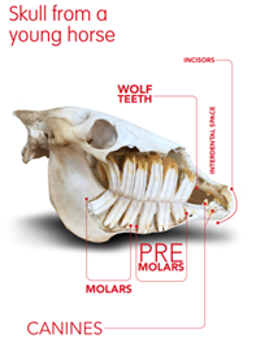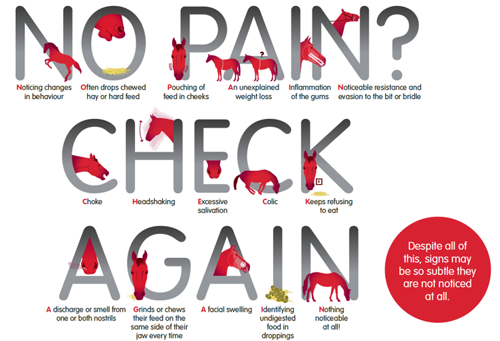Horses are stoic animals, which means they’re incredibly skilled at hiding and disguising their pain, especially when it comes to their teeth. The ability to conceal problems has evolved as a survival technique, which has continued in the modern-day horse.
It’s concerning that 70% of horses may have undiagnosed dental pain1. Regular dental checks are vital to identify problems early and prevent issues worsening.
Did you know:
- Horses’ teeth constantly erupt throughout their lives.
- Horses are born with deep roots, which reduce as their teeth erupt
- Adult horses have between 36-44 teeth
- Males have more teeth than females
- Horses can chew around 30,000 times a day
- Continual chewing will wear their teeth down approximately 2-3mm a year
- Pain from dental disorders will often lead to poor performance
Who to trust with your horse’s teeth
Be aware that currently people don’t legally have to have any qualifications to rasp horses’ teeth. We urge owners to seek recognised, suitably qualified professionals to provide your horse’s dental checks. These are:
- A veterinary surgeon, ideally equine specific
- An Equine Dental Technician (EDT) registered with the British Association of Equine Dental Technicians or category 2 members of The Worldwide Association of Equine Dentistry.
There may be instances when a qualified EDT will have to request a veterinary surgeon to attend for example to sedate your horse, or when more invasive treatment is required.
Points to consider
What happens at a dental check?
chevron-down
chevron-up
Your vet or EDT will discuss the history of your horse and check their teeth. They’ll use a piece of equipment called a mouth speculum (gag) to safely keep your horse’s mouth open while they use bright light, mirrors and dental picks to check for gaps, cavities and disease. They may use a head-stand to hold the horses head up.
Treatment of any issues such as rasping sharp points, overgrowths or uneven wear can be done by hand or electric equipment. The mouth should then be rinsed and re-examined, including removing the gag and checking the alignment of the incisors (front teeth).
Sedation can be given as dental checks can be uncomfortable, especially if pain is present. Sedation will also help your horse to stay relaxed, including relaxing their tongue which will help your vet or EDT to have a better view. If your horse moves during the check-up then problems may be missed. Only a vet can give sedation via injection so your EDT may need your vet’s support.
Your vet or EDT will discuss what they’ve found, including any areas that may be causing pain. Some issues may need further work by your vet to treat such as gaps, cavities and broken teeth.
How often should I have my horse’s teeth checked?
chevron-down
chevron-up
Getting your horse's teeth checked every nine to 12 months will go a long way to making sure they have the healthiest teeth leading into their older years. This recommendation will vary for older horses or those that have specific abnormalities as advised by your vet or EDT.
It's advisable for foals’ teeth to be checked to make sure there’s no developmental abnormalities. A more thorough dental check and rasping often starts from the age of 18 months. These checks are essential before any type of groundwork is started and especially important before introducing the bit for the first time. The presence of any wolf teeth has the potential to cause interference and discomfort. It’s important the horse has a pain-free experience otherwise they may negatively associate that having a bridle put on will cause discomfort or pain.
If you’ve recently purchased a horse, it’s sensible to have their teeth checked as soon as possible. The history of the horse may be unknown to you, and it’s important to identify any problems.

Signs of dental pain
chevron-down
chevron-up
- Noticeable changes in behaviour including headshaking and resistance to the bridle
- Dropping food, pouching of food in the cheeks, only chewing on one side of the jaw or excessively salivating
- Facial swelling, discharge or smell from nostrils, inflammation, swelling or redness of the gums
- Choke, unexplained weight loss, colic, refusing food

Caring for the older horse
chevron-down
chevron-up
Older horses will often need more regular dental checks, and they often have more issues such as decay and gaps between the teeth. They also have smoother surfaces of their teeth that may mean they’ll struggle to grind their food as effectively.
Shorter reserve crowns in older horses mean they can develop displaced or loose teeth that may need removing.
Horses with poor or missing teeth may have uneven wear, large overgrowths and may no longer be able to chew long fibre such as hay and haylage and will benefit from supplementation with mashes or soaked feeds and avoid short chopped stalky forages such as chaff that can be difficult to grind and easily become trapped around the teeth.
Speak to your vet if you have concerns about an older horse.
References
chevron-down
chevron-up
1. Dixon, P. M., Tremaine, W. H., Pickles, K., Kuhns, L., Hawe, C., McCann, J., & Brammer, S. (1999). Equine dental disease part 1: a long‐term study of 400 cases: disorders of incisor, canine and first premolar teeth. Equine veterinary journal, 31(5), 369-377.
2. Sidwell, A. E., Duz, M., Hill, B., Freeman, S., & Hole, S. L. (2025). Application of the horse grimace scale in horses with dental disease: Preliminary findings. Veterinary Record, 196(3), e4800.
3. Dixon, P. M., & Dacre, I. (2005). A review of equine dental disorders. The veterinary journal, 169(2), 165-187.




